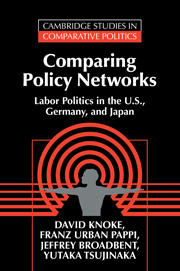Book contents
- Frontmatter
- Contents
- List of tables and figures
- Preface
- Acknowledgements
- 1 Policy-making in the Organizational State
- 2 Three Labor Policy Domains
- 3 Finding Domain Actors
- 4 Organizational Policy Interests
- 5 Policy Webs: Networks, Reputations, and Activities
- 6 Fighting Collectively: Action Sets and Events
- 7 Exchange Processes
- 8 Power Structures
- 9 Variations on a Theme of Organizational States
- Appendix 1 Legislative Procedures in Three Nations
- Appendix 2 Labor Policy Domain Organizations by Type
- Appendix 3 Cluster Analyses of Labor Policy Domain Issues
- Appendix 4 Labor Policy Domain Legislative Bills
- References
- Index
4 - Organizational Policy Interests
Published online by Cambridge University Press: 05 June 2012
- Frontmatter
- Contents
- List of tables and figures
- Preface
- Acknowledgements
- 1 Policy-making in the Organizational State
- 2 Three Labor Policy Domains
- 3 Finding Domain Actors
- 4 Organizational Policy Interests
- 5 Policy Webs: Networks, Reputations, and Activities
- 6 Fighting Collectively: Action Sets and Events
- 7 Exchange Processes
- 8 Power Structures
- 9 Variations on a Theme of Organizational States
- Appendix 1 Legislative Procedures in Three Nations
- Appendix 2 Labor Policy Domain Organizations by Type
- Appendix 3 Cluster Analyses of Labor Policy Domain Issues
- Appendix 4 Labor Policy Domain Legislative Bills
- References
- Index
Summary
As the High Risk Occupational Disease Notification Prevention Act, designed to allow workers exposed to hazardous chemicals to receive medical attention before health problems arose, moved through the U.S. Congress in 1987, business lobbyists attempted to block its passage. Testifying at a Senate Labor Subcommittee hearing, the Chemical Manufacturers Association (CMA) echoed sentiments typical of the business community: A new law was unnecessary because existing statutes were adequate, an avalanche of ruinous lawsuits would ensue, and the high costs of monitoring employees would burden firm resources, especially for small businesses. Yet, within six months, the CMA along with the American Electronics Association and several companies switched sides, joining organized labor, insurance companies, and health associations to support a significantly modified highrisk bill. “When the language was changed so that it literally represented what a lot of our industry is currently doing voluntarily, it made sense to support it,” a CMA spokesperson said (Moretz, 1987: 114). Although ultimately defeated by a coalition of Republican politicians and business organizations, the bill made strange bedfellows of some traditionally opposed interest groups, illustrating the inherent malleability of political issues. As powerful social actors come to identify their interests at stake in national political controversies, so are they motivated to struggle collectively on one side or the other of these conflicts.
This chapter examines the patterns of interests in broad subfields and specific labor policy issues of the 1980s that were expressed by the core organizations in the U.S., German, and Japanese national labor policy domains.
- Type
- Chapter
- Information
- Comparing Policy NetworksLabor Politics in the U.S., Germany, and Japan, pp. 77 - 100Publisher: Cambridge University PressPrint publication year: 1996

